[English] 日本語
 Yorodumi
Yorodumi- EMDB-43178: GPCysRRLL-I53-50A in complex with rabbit 189 wk 18 GPC-A and base... -
+ Open data
Open data
- Basic information
Basic information
| Entry |  | |||||||||
|---|---|---|---|---|---|---|---|---|---|---|
| Title | GPCysRRLL-I53-50A in complex with rabbit 189 wk 18 GPC-A and base epitope pAbs | |||||||||
 Map data Map data | Rabbit 189 wk18 GPC-A pAb | |||||||||
 Sample Sample |
| |||||||||
 Keywords Keywords | Lassa virus / polyclonal antibody / glycoprotein / VIRAL PROTEIN | |||||||||
| Biological species |  | |||||||||
| Method | single particle reconstruction / negative staining / Resolution: 25.0 Å | |||||||||
 Authors Authors | Brouwer PJM / Perrett HR / Ward AB | |||||||||
| Funding support |  United States, 1 items United States, 1 items
| |||||||||
 Citation Citation |  Journal: Cell Rep / Year: 2024 Journal: Cell Rep / Year: 2024Title: Defining bottlenecks and opportunities for Lassa virus neutralization by structural profiling of vaccine-induced polyclonal antibody responses. Authors: Philip J M Brouwer / Hailee R Perrett / Tim Beaumont / Haye Nijhuis / Sabine Kruijer / Judith A Burger / Ilja Bontjer / Wen-Hsin Lee / James A Ferguson / Martin Schauflinger / Helena Müller- ...Authors: Philip J M Brouwer / Hailee R Perrett / Tim Beaumont / Haye Nijhuis / Sabine Kruijer / Judith A Burger / Ilja Bontjer / Wen-Hsin Lee / James A Ferguson / Martin Schauflinger / Helena Müller-Kräuter / Rogier W Sanders / Thomas Strecker / Marit J van Gils / Andrew B Ward /    Abstract: Lassa fever continues to be a major public health burden in West Africa, yet effective therapies or vaccines are lacking. The isolation of protective neutralizing antibodies against the Lassa virus ...Lassa fever continues to be a major public health burden in West Africa, yet effective therapies or vaccines are lacking. The isolation of protective neutralizing antibodies against the Lassa virus glycoprotein complex (GPC) justifies the development of vaccines that can elicit strong neutralizing antibody responses. However, Lassa vaccine candidates have generally been unsuccessful at doing so, and the associated antibody responses to these vaccines remain poorly characterized. Here, we establish an electron microscopy-based epitope mapping workflow that enables high-resolution structural characterization of polyclonal antibodies to the GPC. By applying this method to rabbits vaccinated with a recombinant GPC vaccine and a GPC-derived virus-like particle, we reveal determinants of neutralization that involve epitopes of the GPC-A competition cluster. Furthermore, by identifying undescribed immunogenic off-target epitopes, we expose the challenges that recombinant GPC vaccines face. By enabling detailed polyclonal antibody characterization, our work ushers in a next generation of more rational Lassa vaccine design. | |||||||||
| History |
|
- Structure visualization
Structure visualization
| Supplemental images |
|---|
- Downloads & links
Downloads & links
-EMDB archive
| Map data |  emd_43178.map.gz emd_43178.map.gz | 9.8 MB |  EMDB map data format EMDB map data format | |
|---|---|---|---|---|
| Header (meta data) |  emd-43178-v30.xml emd-43178-v30.xml emd-43178.xml emd-43178.xml | 15.5 KB 15.5 KB | Display Display |  EMDB header EMDB header |
| Images |  emd_43178.png emd_43178.png | 40.2 KB | ||
| Filedesc metadata |  emd-43178.cif.gz emd-43178.cif.gz | 4.2 KB | ||
| Others |  emd_43178_additional_1.map.gz emd_43178_additional_1.map.gz emd_43178_half_map_1.map.gz emd_43178_half_map_1.map.gz emd_43178_half_map_2.map.gz emd_43178_half_map_2.map.gz | 9.8 MB 9.8 MB 9.8 MB | ||
| Archive directory |  http://ftp.pdbj.org/pub/emdb/structures/EMD-43178 http://ftp.pdbj.org/pub/emdb/structures/EMD-43178 ftp://ftp.pdbj.org/pub/emdb/structures/EMD-43178 ftp://ftp.pdbj.org/pub/emdb/structures/EMD-43178 | HTTPS FTP |
-Validation report
| Summary document |  emd_43178_validation.pdf.gz emd_43178_validation.pdf.gz | 669.8 KB | Display |  EMDB validaton report EMDB validaton report |
|---|---|---|---|---|
| Full document |  emd_43178_full_validation.pdf.gz emd_43178_full_validation.pdf.gz | 669.4 KB | Display | |
| Data in XML |  emd_43178_validation.xml.gz emd_43178_validation.xml.gz | 9.4 KB | Display | |
| Data in CIF |  emd_43178_validation.cif.gz emd_43178_validation.cif.gz | 11 KB | Display | |
| Arichive directory |  https://ftp.pdbj.org/pub/emdb/validation_reports/EMD-43178 https://ftp.pdbj.org/pub/emdb/validation_reports/EMD-43178 ftp://ftp.pdbj.org/pub/emdb/validation_reports/EMD-43178 ftp://ftp.pdbj.org/pub/emdb/validation_reports/EMD-43178 | HTTPS FTP |
-Related structure data
- Links
Links
| EMDB pages |  EMDB (EBI/PDBe) / EMDB (EBI/PDBe) /  EMDataResource EMDataResource |
|---|
- Map
Map
| File |  Download / File: emd_43178.map.gz / Format: CCP4 / Size: 12.9 MB / Type: IMAGE STORED AS FLOATING POINT NUMBER (4 BYTES) Download / File: emd_43178.map.gz / Format: CCP4 / Size: 12.9 MB / Type: IMAGE STORED AS FLOATING POINT NUMBER (4 BYTES) | ||||||||||||||||||||||||||||||||||||
|---|---|---|---|---|---|---|---|---|---|---|---|---|---|---|---|---|---|---|---|---|---|---|---|---|---|---|---|---|---|---|---|---|---|---|---|---|---|
| Annotation | Rabbit 189 wk18 GPC-A pAb | ||||||||||||||||||||||||||||||||||||
| Projections & slices | Image control
Images are generated by Spider. | ||||||||||||||||||||||||||||||||||||
| Voxel size | X=Y=Z: 2.06 Å | ||||||||||||||||||||||||||||||||||||
| Density |
| ||||||||||||||||||||||||||||||||||||
| Symmetry | Space group: 1 | ||||||||||||||||||||||||||||||||||||
| Details | EMDB XML:
|
-Supplemental data
-Additional map: Rabbit 189 wk18 base pAb
| File | emd_43178_additional_1.map | ||||||||||||
|---|---|---|---|---|---|---|---|---|---|---|---|---|---|
| Annotation | Rabbit 189 wk18 base pAb | ||||||||||||
| Projections & Slices |
| ||||||||||||
| Density Histograms |
-Half map: Rabbit 189 wk18 GPC-A pAb
| File | emd_43178_half_map_1.map | ||||||||||||
|---|---|---|---|---|---|---|---|---|---|---|---|---|---|
| Annotation | Rabbit 189 wk18 GPC-A pAb | ||||||||||||
| Projections & Slices |
| ||||||||||||
| Density Histograms |
-Half map: Rabbit 189 wk18 GPC-A pAb
| File | emd_43178_half_map_2.map | ||||||||||||
|---|---|---|---|---|---|---|---|---|---|---|---|---|---|
| Annotation | Rabbit 189 wk18 GPC-A pAb | ||||||||||||
| Projections & Slices |
| ||||||||||||
| Density Histograms |
- Sample components
Sample components
-Entire : GPCysRRLL-I53-50A+8.9F Fab in complex with rabbit 189 wk18 GPC-A ...
| Entire | Name: GPCysRRLL-I53-50A+8.9F Fab in complex with rabbit 189 wk18 GPC-A and base pAbs |
|---|---|
| Components |
|
-Supramolecule #1: GPCysRRLL-I53-50A+8.9F Fab in complex with rabbit 189 wk18 GPC-A ...
| Supramolecule | Name: GPCysRRLL-I53-50A+8.9F Fab in complex with rabbit 189 wk18 GPC-A and base pAbs type: complex / ID: 1 / Parent: 0 |
|---|---|
| Source (natural) | Organism:  |
-Experimental details
-Structure determination
| Method | negative staining |
|---|---|
 Processing Processing | single particle reconstruction |
| Aggregation state | particle |
- Sample preparation
Sample preparation
| Concentration | 0.015 mg/mL |
|---|---|
| Buffer | pH: 7.4 |
| Staining | Type: NEGATIVE / Material: Uranyl Formate / Details: 2% w/v |
| Grid | Model: Homemade / Support film - Material: CARBON / Support film - topology: CONTINUOUS |
- Electron microscopy
Electron microscopy
| Microscope | FEI TECNAI SPIRIT |
|---|---|
| Image recording | Film or detector model: FEI EAGLE (4k x 4k) / Average electron dose: 25.0 e/Å2 |
| Electron beam | Acceleration voltage: 120 kV / Electron source: LAB6 |
| Electron optics | Illumination mode: FLOOD BEAM / Imaging mode: BRIGHT FIELD / Nominal defocus max: 1.5 µm / Nominal defocus min: 1.0 µm |
| Sample stage | Cooling holder cryogen: NITROGEN |
| Experimental equipment | 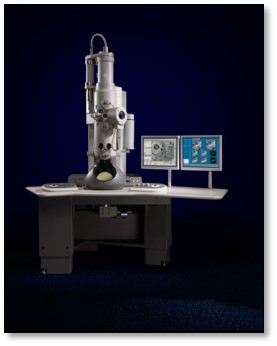 Model: Tecnai Spirit / Image courtesy: FEI Company |
- Image processing
Image processing
| Startup model | Type of model: PDB ENTRY PDB model - PDB ID:  8er3 Details: The startup model also contains the I53-50A scaffold (7SGE) and a constant domain for 8.9F Fab was added by overlaying with full rabbit Fab (4ZTP). The overall complex was low pass filtered in UCSF Chimera. |
|---|---|
| Final reconstruction | Resolution.type: BY AUTHOR / Resolution: 25.0 Å / Resolution method: FSC 0.5 CUT-OFF / Software - Name: RELION / Number images used: 2937 |
| Initial angle assignment | Type: MAXIMUM LIKELIHOOD |
| Final angle assignment | Type: MAXIMUM LIKELIHOOD |
 Movie
Movie Controller
Controller
























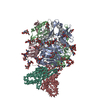
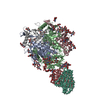
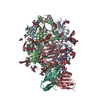

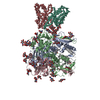
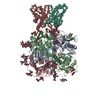
 Z (Sec.)
Z (Sec.) Y (Row.)
Y (Row.) X (Col.)
X (Col.)












































